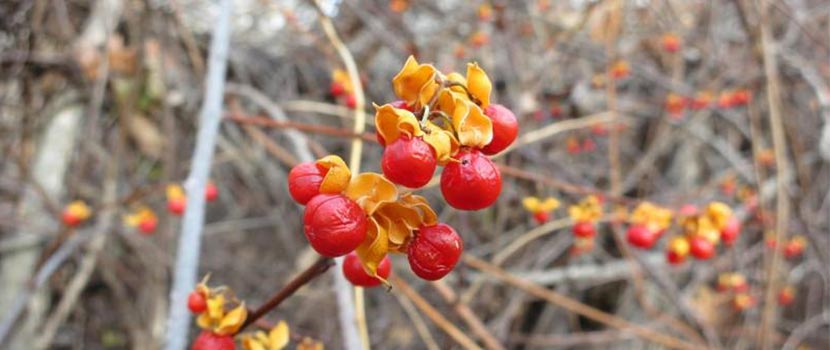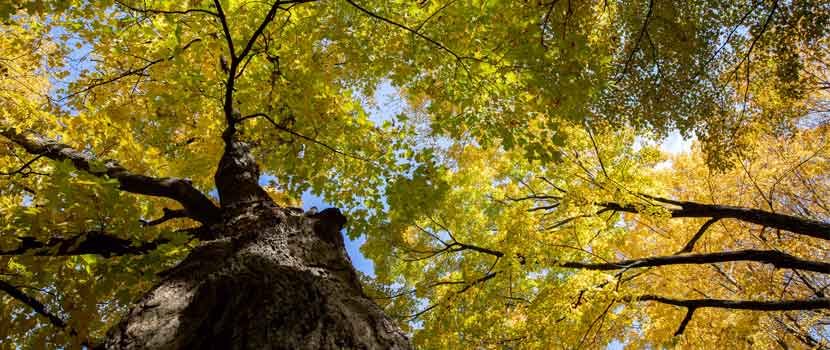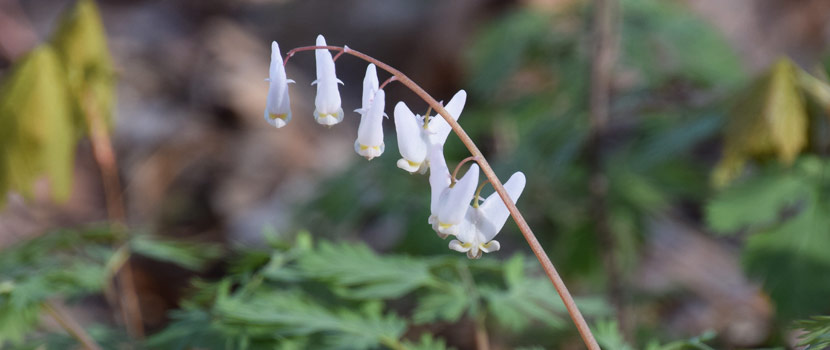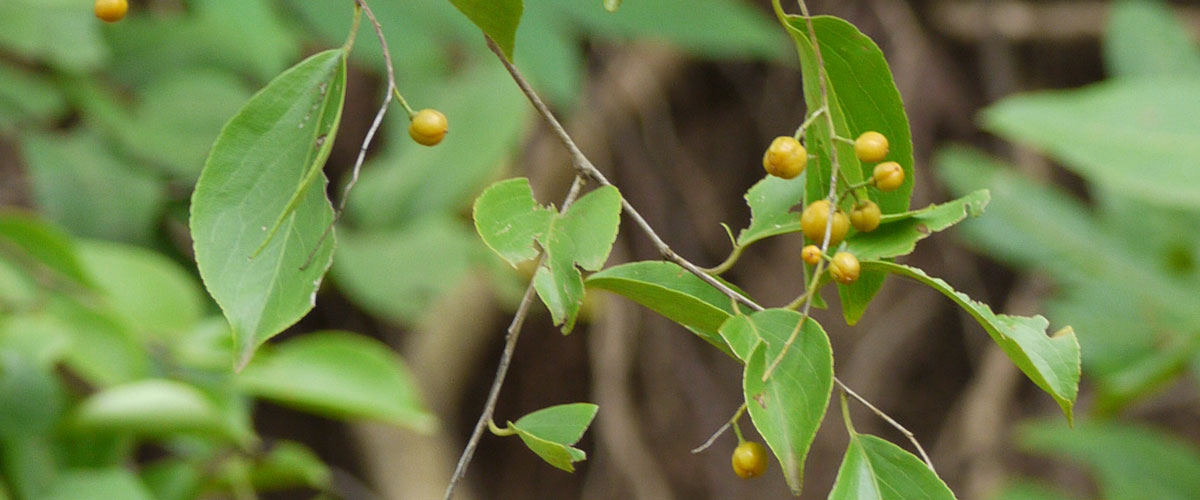
Controlling Invasives: Anatomy of an Ecological Restoration
By: Paul Kortebein
November 29, 2021
Category: Resource Management
The Natural Resources Management department at Three Rivers does a lot of ecological restoration work. This work involves re-establishing appropriate native plant communities, with the goal of making them as self-sustaining as possible by limiting the prevalence of undesirable plants.
Curious how this works? Follow me as I walk you through an ongoing restoration project here at Three Rivers that involves controlling Oriental bittersweet – a very tenacious vine.
What’s the Problem?
Much of our restoration activity revolves around controlling undesirable, non-native species. Not all non-native plants are created equal, however. Some can persist in the background without really affecting the overall balance of the ecosystem they are in.
Dandelions are a prime example. Originally from Eurasia, dandelions have spread far and wide throughout North America, but rarely have they suppressed other vegetation to completely take over an area. You might not like the way they look in your lawn, but the overall function and existence of the lawn is not threatened by them being there. Other plants, however, can significantly alter ecosystem function.
Oriental bittersweet (Celastrus orbiculatus) is one of them. This aggressive climbing vine poses a serious problem for nearly all woody (trees and shrubs) plant communities. This includes everything from mature forests to young, successional forests.
Oriental bittersweet can grow up to 15 feet per year. Because of this rapid growth rate, it climbs over everything, even the tallest trees. It can kill plants by preventing them from getting sunlight necessary for growth, or by “girdling” trees as it climbs. Girdling happens because, as the tree grows in width, the bittersweet does not. Because of this it will slowly constrict the tree and prevent the movement of water and nutrients within the tree. Talk about your long, slow death!
You can see how quickly Oriental bittersweet populations can grow from year-to-year in the below maps of a section of Elm Creek Park Reserve.
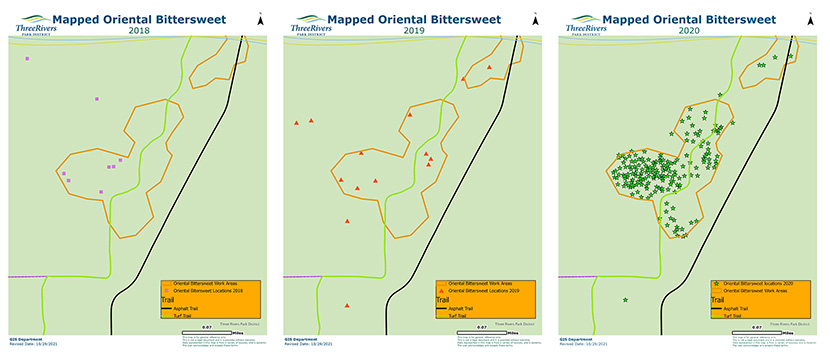
The effects Oriental bittersweet has on Minnesota plant systems is so serious that the Minnesota Department of Agriculture has listed Oriental bittersweet as a “Prohibited – Eradicate” plant. This means we need to attempt to control it wherever we find it.
Assess, Identify, Assess
The first step in an ecological restoration is to determine what invasive species are in the park and how much of a threat it is to what we want to be there. This requires some time getting familiar with a variety of native and non-native plants. It will also likely take multiple seasons to determine the overall trajectory of the plant communities. Are undesirable species spreading? If so, how fast? And are they affecting native species survival?
Determining the need for restoring habitat requires knowing what you have to start with, which usually means going for walks or boat rides. The Oriental bittersweet removal project started the same way: by taking a walk and looking for the plant. Getting this baseline knowledge helps us understand what kind of time needs to be invested into the restoration project.
In some cases, this assessment requires a closer look. This is the case with Oriental bittersweet because there is also a native bittersweet, called American bittersweet (Celastrus scandens), that looks very similar. Being able to differentiate between the two is critical.
One easy way to tell them apart is where the fruit is growing. Native bittersweet fruit grows only at the end of the branch, while the oriental variety will have fruit at most locations where there is a leaf along the stem. There are, of course, other differences, but this is the easiest to see at the right time of the year, specifically late fall or early winter. (If you want to geek out on differentiating between these plants, you can learn more from the Minnesota Department of Agriculture.)
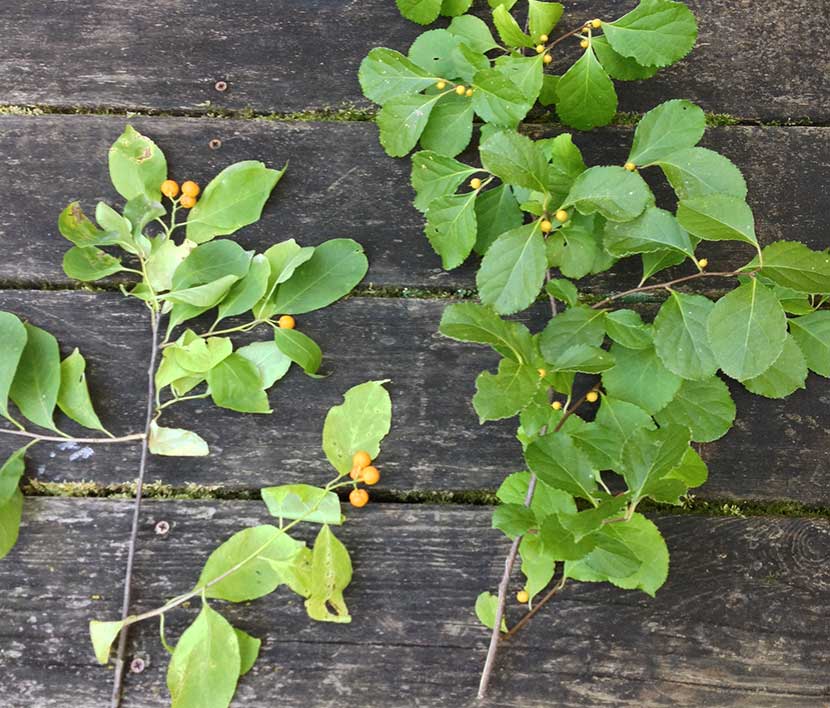
We found that Elm Creek Park Reserve has the vast majority of Oriental bittersweet in the Three Rivers Park District. A map of the largest problem areas is below. These areas have been expanding since about 2018, and most of these sites are easily observable from nearby turf trails.
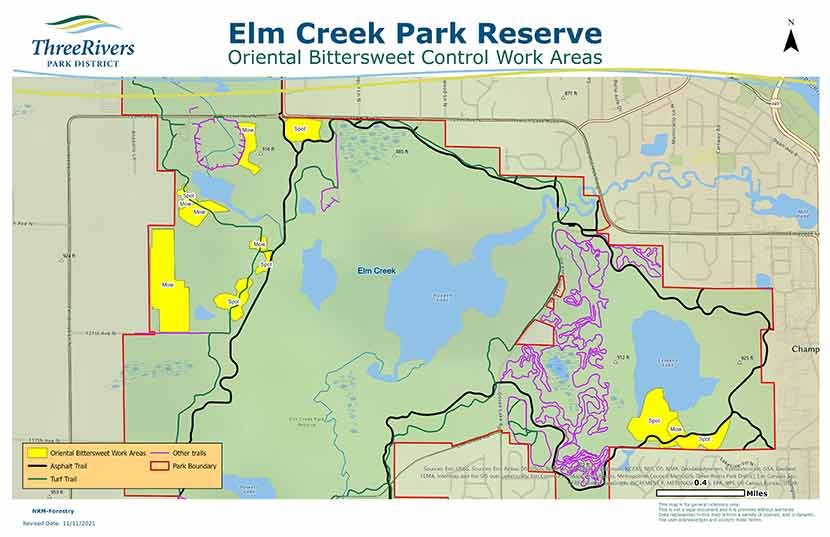
Take Action
After the assessment is complete, it’s time to get to work on deconstructing and reconstructing.
While much of the ecological restoration we do in our parks is completed by our staff, recent efforts to eliminate Oriental bittersweet have involved additional support.
Through funding from the Conservation Partners Legacy grant program, Three Rivers is in the midst of work to restore roughly 145 acres in the Elm Creek, Lake Rebecca and Crow-Hassan park reserves. Conservation Partners Legacy funds ecological restoration projects throughout the state and is paid for by the Clean Water, Land and Legacy Amendment passed in 2008. The funding for this particular project lasts through June 30, 2023.
The goal of this project is to eradicate the Oriental bittersweet from all work areas.
The initial phase involves targeting the removal of the invasive plants. To do this, we basically need to start over vegetatively, which means removing all grass and other plants. So, beginning in December 2020, we hired a contractor to remove all undesirable plants within the worst areas, including Oriental bittersweet. This involved a lot of mowing shrubs and cutting trees.
We also had the contractor do targeted control of individual plants in locations with a lower Oriental bittersweet density.
Using this very intensive management approach through 2023, we hope to completely eradicate this plant from all of the designated work areas.
Once the invasive plants are removed, our goal is to restore these areas to native forest cover, using our tried-and-true reforestation planting methods, which uses a diverse mix of native plants grown at our nursery. In fact, every spring and fall we successfully do reforestation plantings at various locations throughout Three Rivers Parks.
So, keep your eyes on these sites over the next five years and watch how they change. The work takes time but has a big impact: Planting efforts by the Three Rivers' Forestry staff over more than 40 years resulted in most of the woods you see in our parks today.
You Can Help
Here are a few ways you can help protect our natural areas when it comes to invasive species:
- Purchase plants from a reliable vendor. Some vines sold as American bittersweet have mistakenly turned out to be Oriental bittersweet.
- Follow Three Rivers Natural Resources on Facebook and watch for Oriental bittersweet blitzes. These events, organized by our invasive species coordinator, Emily Dunlap, help locate and confirm new occurrences of the species in our parks. You can also volunteer for twice-yearly events to remove invasive species.
- Learn how to identify this invasive species and report infestations you see to the organization that manages the land.
- Help find and map where it is found in Three Rivers by joining the Rapid Response and Early Detection (R2ED) Team.
Banner image: "Kasara-tige (Telugu: కాసరతీగె)" by Dinesh Valke is licensed under CC BY-SA 2.0 / cropped and resized from the original
About the Author

Paul is the Manager of Forestry and Horticulture at Three Rivers Park District – a position he has held for the past 10 years. Prior to that he was stomping around the wilds of Milwaukee County as the natural areas manager, and before that he was stomping around the wilds of New York City (yes, there are some) as an environmental restoration project manager for the New York City Department of Parks and Recreation. In his spare time he enjoys installing flashing on old windows.
Related Blog Posts
Colorful Winter Vines: A Bittersweet Problem
By: Missy Anderson
Around the Twin Cities, there is a woody vine that looks similar to one of our native vines — but is highly invasive. Read on to learn why oriental bittersweet is a problem, how to distinguish it from American bittersweet and what you can do to help.
Growing Resilient Forests at the Three Rivers Nursery
By: Missy Anderson
Did you know that we have our own plant nursery at Three Rivers? Learn all about why we grow our own plants and how we work to ensure the forests in our parks will be around for years to come.
What's Happening to Our Woodland Understories?
By: Paul Kortebein
Native woodland plants are disappearing from our forests. Learn what's causing this and how we're working to protect our forest understories.
